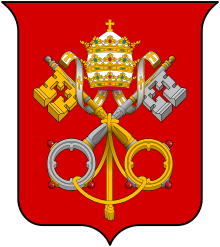Pope Julius II
| Pope Julius II | |
|---|---|
|
| |
| Papacy began | 1 November 1503 |
| Papacy ended | 21 February 1513 |
| Predecessor | Pius III |
| Successor | Leo X |
| Orders | |
| Ordination | 1471 |
| Consecration |
1481 by Sixtus IV |
| Created Cardinal |
15 December 1471 by Sixtus IV |
| Personal details | |
| Birth name | Giuliano della Rovere |
| Born |
5 December 1443 Albisola, Republic of Genoa |
| Died |
21 February 1513 (aged 69) Rome, Papal States |
| Parents | Rafaello della Rovere and Theodora Manerola |
| Children | Felice della Rovere |
| Previous post |
Archbishop of Avignon (1474–1503) Cardinal-bishop of Sabina (1479–1483) Camerlengo of the Sacred College of Cardinals (1479) Cardinal-bishop of Ostia (1483–1503) |
| Other popes named Julius | |
| Papal styles of Pope Julius II | |
|---|---|
 | |
| Reference style | His Holiness |
| Spoken style | Your Holiness |
| Religious style | Holy Father |
| Posthumous style | None |
Pope Julius II (Latin: Iulius II; 5 December 1443 – 21 February 1513), nicknamed "The Fearsome Pope"[1] and "The Warrior Pope",[2] born Giuliano della Rovere, was Pope from 1 November 1503 to his death in 1513. His papacy was marked by an active foreign policy, ambitious building projects, and patronage for the arts—he commissioned the destruction and rebuilding of St. Peter's Basilica, plus Michelangelo's decoration of the ceiling of the Sistine Chapel. In addition to an active military policy, he personally led troops into battle on at least two occasions.
Early life
There is disagreement about Julius's year of birth, for some sources put it as late as 1453.[3] Giuliano della Rovere was the son of Rafaello della Rovere.[4] Francesco della Rovere (later Pope Sixtus IV) was his uncle.[5]
He was educated among the Franciscans by his uncle, who took him under his special charge and later sent him to a Franciscan friary in Perugia with the purpose of obtaining knowledge of the sciences.[6] As Belford-Clarke's piratised Americanized [version of] Encyclopædia Britannica (1890) states, "He does not appear to have joined the order of St. Francis, but to have remained one of the secular clergy until his elevation in 1471 to be bishop of Carpentras [in France], shortly after his uncle succeeded to the papal chair."[7]
Cardinalate
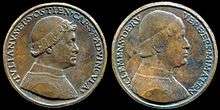
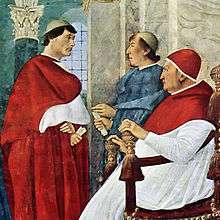
After his uncle was elected Pope Sixtus IV, (as Belford-Clarke states) della Rovere "was promoted to be cardinal, taking the same title as that formerly held by his uncle, [Cardinal of] St. Peter ad Vincula. With his uncle [as Pope] he obtained very great influence, and in addition to the archbishopric of Avignon he held no fewer than eight bishoprics,"[7] including Lausanne from 1472, and Coutances from 1476.[8] In June 1474, della Rovere led an army to Todi and Spoleto, and the Città di Castello.[4]
Belford-Clarke, and Kellogg, Baynes & Smith, continue, "In the capacity of papal legate [della Rovere] was sent in 1480 to France, where he remained four years,"[7][9] and "acquitted himself with such ability that he soon acquired a paramount influence in the college of cardinals, an influence which rather increased than diminished during the pontificate of Pope Innocent VIII."[9] Around this time, in 1483, an illegitimate daughter was born, Felice della Rovere.[10]
Kellogg, Baynes & Smith, continue, a "rivalry had, however, gradually grown up between [della Rovere] and [then-Cardinal] Rodrigo Borgia, and on the death of Innocent VIII in 1492 Borgia by means of a secret agreement [and simony] with Ascanio Sforza succeeded in being elected by a large majority, under the name of Pope Alexander VI."[9] Della Rovere, jealous and angry, accused Borgia of being elected over him.[11]
Kellogg, Baynes & Smith, then note that "[d]ella Rovere at once determined to take refuge [from Borgia's wrath] at Ostia, and in a few months afterwards went to Paris, where he incited Charles VIII to undertake the conquest of Naples."[9] In 1494 he joined Charles VIII of France who was undertaking a military expedition into Italy.[4] Charles soon conquered Naples.[12]
Kellogg, Baynes & Smith continue: "Accompanying the young king on his military campaign, [della Rovere] entered Rome along with him, and endeavoured to instigate the convocation of a council to inquire into the conduct of the pontiff with a view to [deposing him], but Alexander, having gained a friend in Charles VIII's minister [Guillaume] Briçonnet, by the offer of a cardinal's hat, succeeded in counterworking [defeating] the machinations of his enemy [della Rovere]."[9]
Belford-Clarke notes that on "the death of [Pope] Alexander VI in 1503 [where his son, Cesare Borgia, fell ill at the same time] Della Rovere supported the candidature of Cardinal Piccolomini of Milan, who was consecrated under the name of Pope Pius III [on 8 October 1503], …then suffering from an incurable malady, of which he died in little more than a month afterward."[7]
Election
As Belford-Clarke describes it, "Della Rovere then succeeded by dexterous diplomacy in winning the support of Cesare Borgia, [who he tricked by his "promise of money and continued papal backing for Borgia policies in the Romagna,"[13]] and was elected to the papal dignity [as Pope Julius II] by the unanimous vote of the cardinals."[7] This was, in Andrew Greeley's view, almost certainly by means of bribery with money,[14] but also, per Ott, Ullman, and Hughes, with promises.[15] [16] [4] Indeed, his election only took a few hours, and the only two votes he did not receive were his own and the one of Georges d'Amboise, supposedly his main opponent and the favourite of the French monarchy.[17]
Papacy
Giuliano Della Rovere thenceforth took the name of his fourth century predecessor, Julius I, and was pope for nine years, from 1503 to 1513.
From the beginning, Julius II set out to defeat the various powers that challenged his temporal authority; in a series of complicated stratagems he first succeeded in rendering it impossible for the Borgias to retain their power over the Papal States. Indeed, on the day of his election, he declared
"I will not live in the same rooms as the Borgias lived. He [Alexander VI] desecrated the Holy Church as none before. He usurped the papal power by the devil's aid, and I forbid under the pain of excommunication anyone to speak or think of Borgia again. His name and memory must be forgotten. It must be crossed out of every document and memorial. His reign must be obliterated. All paintings made of the Borgias or for them must be covered over with black crepe. All the tombs of the Borgias must be opened and their bodies sent back to where they belong—to Spain."[18]
The Borgias' apartments remained sealed until the 19th Century.[18]
Julius II then used his influence to reconcile the two powerful Roman families of Orsini and Colonna, and, by decrees made in their interest, he also attached to himself the remainder of the Roman nobility.
Being thus secure in Rome and the surrounding country, he next set himself to oust the Republic of Venice from Faenza, Rimini, and the other towns and fortresses of Italy which it occupied after the death of Pope Alexander.[4][19] In 1504, finding it impossible to succeed with the Doge of Venice by remonstrance, he brought about a union of the conflicting interests of France and the Holy Roman Empire, and sacrificed temporarily to some extent the independence of Italy to conclude with them an offensive and defensive alliance against Venice.[20][21] The combination was, however, at first little more than nominal, and was not immediately effective in compelling the Venetians to deliver up more than a few unimportant places in the Romagna.[4] With a campaign in 1506, he personally led an army to Perugia and Bologna, freeing them from their despots (Giampolo Baglioni and Giovanni II Bentivoglio, respectively).[4]
In December 1503, Julius issued a dispensation allowing Henry VIII of England to marry Catherine of Aragon; Catherine had previously been briefly married to Henry's brother Prince Arthur, who had died, but maintained that she had remained a virgin for the six months of the marriage. (Some twenty years later, when Henry was in love with Anne Boleyn, he would seek to have his marriage annulled, claiming that the dispensation should never have been issued.) The refusal of Pope Clement VII to grant the annulment led to the English Reformation.
His Ea quae pro bono pacis of January 24, 1506, confirmed papal approval of the mare clausum policy being pursued by Spain and Portugal amid their explorations, and approved the changes of the 1494 Treaty of Tordesillas to previous papal bulls. The same year, he founded the Swiss Guard to provide a constant corps of soldiers to protect the Pope.
As part of the Renaissance programme of reestablishing the glory of antiquity for the Christian capital, Rome, Julius II took considerable effort to present himself as a sort of emperor-pope, capable of leading a Latin-Christian empire. On Palm Sunday, 1507, "Julius II entered Rome . . . both as a second Julius Caesar, heir to the majesty of Rome's imperial glory, and in the likeness of Christ, whose vicar the pope was, and who in that capacity governed the universal Roman Church."[22] Julius, who modelled himself after his namesake Caesar, would personally lead his army across the Italian peninsula under the imperial war-cry, "Drive out the barbarians."[23] Yet, despite the imperial rhetoric, the campaigns of Julius were highly local.
League of Cambrai and Holy League
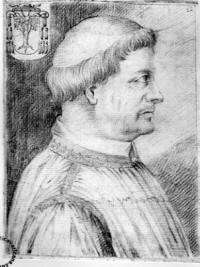
In 1508, events so favoured the plans of Julius that he was able to form the League of Cambrai with Louis XII, King of France, Maximilian I, Holy Roman Emperor, and Ferdinand II, King of Aragon. The League fought against the Republic of Venice during the "War of the Holy League" (also known as the "War of the League of Cambrai"). Among other things, Julius wanted the Venetian possession of Romagna; Emperor Maximilian I wanted Friuli and Veneto; Louis XII wanted Cremona; and Ferdinand II wanted the Apulian ports.[19][24] This war was a conflict in what was collectively known as the "Italian Wars".
In the spring of 1509, the Republic of Venice was placed under an interdict by Julius,[25] and later in 1509 Julius sent troops to fight against the Venetians who had occupied parts of the Romagna.[4] During the "War of the Holy League" and the "Italian Wars", alliances and participants changed dramatically; for example, in 1510 Venice and France switched places, and by 1513, Venice had joined France.
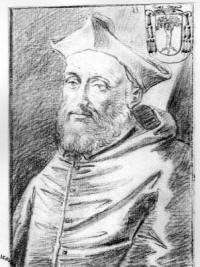
The achievements of the League soon outstripped the primary intention of Julius. In one single battle, the Battle of Agnadello on 14 May 1509, the dominion of Venice in Italy was practically lost. But, as neither the King of France nor the Holy Roman Emperor were satisfied with merely effecting the purposes of the Pope, the latter found it necessary to enter into an arrangement with the Venetians to defend himself from those who immediately before had been his allies. The Venetians, on making humble submission, were absolved at the beginning of 1510, and shortly afterward France was placed under papal interdict. Attempts to cause a rupture between France and England proved unsuccessful; on the other hand, at a synod convened by Louis at Tours in September 1510, the French bishops withdrew from papal obedience, and resolved, with Emperor Maximilian's co-operation, to seek the deposition of the pope. After this, in 1510 Julius II personally led his army to Bologna and Mirandola against French troops.[4] In November 1511, a council met at Pisa, called by rebel cardinals with support from the French king and the Empire, to seek the deposition of Charles II at Pisa.[26]
Julius thereupon entered into the Holy League of 1511: he allied with Ferdinand II of Aragon and the Venetians against France. In short time, both Henry VIII, King of England (1509–47), and Maximilian I also joined the Holy League of 1511.
Julius hired Swiss mercenaries to fight against the French in Milan in May 1512.[20][27] Julius also convened a general council (that afterward was known as the Fifth Council of the Lateran) to be held at Rome in 1512, which, according to an oath taken on his election, he had bound himself to summon, but which had been delayed, he affirmed, because of the occupation of Italy by his enemies.
During his last months of life, he engaged in negotiations with Ferdinand's diplomats, who obtained from him the ideological back-up necessary for Ferdinand II of Aragon's invasion of Navarre in the form of papal bulls.
Death
In 1512 the French were driven across the Alps, but it was at the cost of the occupation of Italy by the other powers, and Julius, though he had securely established the papal authority in the states immediately around Rome, was practically as far as ever from realizing his dream of an independent Italian kingdom when he died of fever in February 1513.
It is a common error that many associate the burial place of Julius as being in San Pietro in Vincoli as the location for the so-called "Tomb of Julius" by Michelangelo. However, this tomb was not completed until 1545 and represents a much abbreviated version of the planned original, which was initially intended for the new St. Peter's Basilica. Instead, as was always intended, Julius was buried in St. Peter's in the Vatican.
His remains, along with those of his uncle, Pope Sixtus IV, were later desecrated during the Sack of Rome in 1527. Today, the remains of both lie in St. Peter's in the floor in front of the monument to Pope Clement X. A simple marble tombstone marks the site.
He was succeeded by Pope Leo X.
Legacy
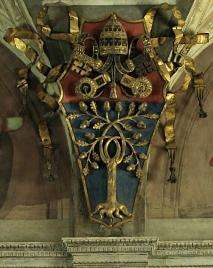
Patronage of the arts
Despite Julius II's political and bellicose achievements, his chief title to honor is to be found in his patronage of art and literature.[28] He did much to improve and beautify the city. In 1506 he laid the foundation stone of the new St. Peter's Basilica. However, he also demolished the old St. Peter's Basilica, which had stood for more than 1,100 years. He was a friend and patron of Bramante and Raphael, and a patron of Michelangelo. Several of Michelangelo's greatest works (including the painting of the ceiling of the Sistine Chapel) were commissioned by Julius.
Character
Appearance
Julius II is usually depicted with a beard, after his appearance in the celebrated portrait by Raphael. However, the pope only wore his beard from 27 June 1511 to March 1512, as a sign of mourning at the loss of the city of Bologna by the Papal States. He was nevertheless the first pope since antiquity to wear a beard, a practice otherwise forbidden by canon law since the 13th century. Julius shaved his beard again before his death, and his immediate successors were clean-shaven; however, Pope Clement VII again adopted the beard as a sign of mourning after the 1527 sack of Rome. Thenceforward, all popes were bearded until the death of Pope Innocent XII in 1700.
%2C_detail.jpg)
Personal relationships and sexuality
Julius was not the first pope to have fathered children before being elevated to high office, and is believed to have had a daughter born to Lucrezia Normanni in 1483 - after he had been made a cardinal. Felice della Rovere survived into adulthood. Pompeo Litta[29] mistakenly ascribed Felice's two daughters, Giulia and Clarice, to him as well. Shortly after Felice was born, Julius arranged for Lucrezia to marry Bernardino de Cupis. Bernardino was the chamberlain of Julius's cousin, Cardinal Girolamo Basso della Rovere.[30]
Despite an illegitimate daughter (and at least one mistress), it was also suggested that Julius may have had homosexual lovers - although there is no evidence that he was sexually active as pope. His confrontational style inevitably created enemies and sodomy was the "common currency of insult and innuendo".[31] Such accusations were made to discredit him, but perhaps in doing so accusers were attacking a perceived weak point. The Venetians — who were opposed to the pope's new military policy - were among the most vocal; most notably the diarist Girolamo Priuli,[32] and the historian Marino Sanudo.[33] Erasmus also implied sexual misconduct in his 1514 dialogue "Julius Excluded from Heaven"; a theme picked up in the denunciation made at the conciliabulum of Pisa.[34] Criticism was furthermore made of the sinister influence exerted by his advisor, Francesco Alidosi, who Julius had made a cardinal in 1505. However, it is likely that the closeness was down to the fact that he simply knew how to handle him well.[31][35] This sexual reputation survived Julius, and the accusation continued to be made without reservation by Protestant opponents in their polemics against "papism" and Catholic decadence. The French writer Philippe de Mornay (1549-1623) accused all Italians of being sodomites, but added specifically: "This horror is ascribed to good Julius."[36]
Depiction
- Julius features prominently in The Prince of Niccolò Machiavelli, both as an enemy of leading protagonist Cesare Borgia, and as an example of an ecclesiastical prince who consolidates authority and wisely follows Fortuna.
- Barbara Tuchman, in her book The March of Folly: From Troy to Vietnam, offers a vivid narrative of Julius II's career.[37] Her overall assessment of Julius is strongly negative, and she attributes the Protestant Reformation to his and other Renaissance popes' abuses.[37]
- In the film The Agony and the Ecstasy about the life of Michelangelo, Julius is vividly portrayed as a soldier-pope by Rex Harrison. The film is a dramatization based upon the book of the same name by Irving Stone.
- Della Rovere was portrayed by Alfred Burke in the 1981 BBC series The Borgias, by Colm Feore In Neil Jordan's 2011 series The Borgias, and by Dejan Čukić in Tom Fontana's 2011 series, Borgia.
See also
References
- ↑ Blech, Benjamin; Doliner, Roy. (2008). The Sistene Secrets. New York, NY: HarperCollins Publishers. p. 106. ISBN 978-0-06-146904-6.
- ↑ Jokinen, Anniina (15 Mar 2003). "Pope Julius II". Luminarium. Retrieved 7 October 2013.
- ↑ Cheney, David M. "Pope Julius II (Giuliano della Rovere)". Catholic-Hierarchy. Retrieved 2013-10-07.
- 1 2 3 4 5 6 7 8 9 Ott, Michael (1910). "Pope Julius II". The Catholic Encyclopedia. 8. New York, NY: Robert Appleton Co. Retrieved 15 April 2016.
Born on 5 December 1443, at Albissola near Savona; crowned on 28 November 1503; died at Rome, in the night of 20–21 February 1513. He was born of a probably noble but impoverished family, his father being Raffaelo della Rovere and his mother Theodora Manerola, a lady of Greek extraction… / To ensure his success he made great promises to the cardinals, and did not hesitate to employ bribery.
- ↑ Kühner, Hans (2013). "Julius II". Encyclopædia Britannica. Encyclopædia Britannica Inc. Retrieved 7 October 2013.
Giuliano was the son of the impoverished Rafaello della Rovere, Pope Sixtus IV's only brother.
- ↑ Paul F. Grendler, ed., Encyclopedia of the Renaissance: Galen-Lyon (Renaissance Society of America, 1999), p. 361
- 1 2 3 4 5 Belford-Clarke Co. (1890). "Julius II". Americanized Encyclopædia Britannica: A Dictionary of Arts, Sciences and Literature, to Which is Added Biographies of Living Subjects, 96 Color Maps and Numerous Illustrations. Vol. VI.—HIR—LIB. (Revised and Amended ed.). Chicago, IL: Belford-Clarke. p. 3680. Retrieved 15 April 2016.
- ↑ Williams, George L., Papal Genealogy, McFarland, 2004 ISBN 9780786420711
- 1 2 3 4 5 Kellogg, Otis Day; Baynes, Spencer & Smith, W. Robertson, Eds. (1898). "Julius II". The Encyclopædia Britannica, Latest Edition, A Dictionary of Arts, Sciences and General Literature… with New American Supplement. XIII. New York, NY: The Werner Company. p. 771. Retrieved 15 April 2016.
- ↑ Caroline P. Murphy, The Pope’s Daughter: The Extraordinary Life of Felice della Rovere. (Oxford University Press, 2005), xv, 11.
- ↑ Sabatini, Raphael (1912). The Life of Cesare Borgia. London: Stanley Paul & Company. p. 426.
- ↑ R. Ritchie, Historical Atlas of the Renaissance, p. 64.
- ↑ "Cesare Borgia". Encyclopedia of World Biography. Farmington Hills, MI: Encyclopedia.com/The Gale Group. 2004. Retrieved April 15, 2016.
- ↑ Greeley, Andrew M. (2005). The Making of the Pope 2005. New York: Little, Brown. p. 22. ISBN 978-0-316-32560-8.
- ↑ Ullmann, Walter (1972). "Julius and the Schismatic Cardinals". In Baker, Derek. Schism, Heresy and Religious Protest: Papers Read at the Tenth Summer Meeting and the Eleventh Winter Meeting of the Ecclesiastical History Society. Cambridge, England: Ecclesiastical History Society by Cambridge University Press. pp. 177–178. ISBN 978-0-521-08486-4.
- ↑ Hughes, Philip (1979). "Chapter V: 'Facilis Descensus ...' 1471–1517: A Papacy of Princes". History of the Church: Volume 3: The Revolt Against the Church: Aquinas to Luther (revised ed.). London: Sheed & Ward. p. 415. ISBN 978-0-7220-7983-6.
- ↑ Adams, John P. (16 December 2012). "Sede Vacante 1503, II". Csun.edu. Retrieved 2013-10-07.
- 1 2 Cawthorne, Nigel (1996). Sex Lives of the Popes. Prion. p. 219. ISBN 9781853755460.
- 1 2 Shaw, Christine. Julius II: The Warrior Pope. Oxford: Blackwell Publishers, 1993. ISBN 0-631-16738-2, pages 127-132, 135-139, 228-234
- 1 2 John Julius Norwich A History of Venice. New York: Vintage Books, 1989. ISBN 0-679-72197-5, pages 392, 423-424
- ↑ Mallett, Michael and Christine Shaw. The Italian Wars, 1494–1559: War, State and Society in Early Modern Europe. Harlow, England: Pearson Education Limited, 2012. ISBN 978-0-582-05758-6, page 85
- ↑ Stinger, Charles M. The Renaissance in Rome (Indiana University Press, 1985).
- ↑ Adams, Robert M., "Introduction," The Prince Niccolo Machiavelli (Norton, 1992), 72, n3.
- ↑ Guicciardini, Francesco. The History of Italy. Translated by Sydney Alexander. Princeton: Princeton University Press, 1984. ISBN 0-691-00800-0, pages 196-197
- ↑ Cavendish, Richard (2009). "Venice Excommunicated". History Today. History Today Ltd. 59 (4). (subscription required)
- ↑ Augustin Renaudet, Le concile Gallican de Pise-Milan, Paris: H. Champion, 1922.
- ↑ Charles Oman, A History of the Art of War in the Sixteenth Century. London: Methuen & Co., 1937, page 152.
- ↑ Baldwin, Robert (2010). "Papal Politics and Raphael's Stanza Della Segnatura as Papal Golden Age" (PDF). Social History of Art, by Robert Baldwin.
- ↑ Litta, "Famiglie Celebri Italiane" (Celebrated Italian Families), 1833
- ↑ A definitive life of Felice della Rovere is in Caroline P. Murphy's The Pope’s Daughter: The Extraordinary Life of Felice della Rovere. (Oxford University Press, 2005)
- 1 2 Christine Ward, Julius II: Warrior Pope
- ↑ G. Priuli, Diarii, in Rerum italicarum scriptores, Vol 24, Bologna, 1938.
- ↑ M. Sanudo, I diarii, Venice 1879–1902
- ↑ Ed. Jan Sperna Weil, Erasmus of Rotterdam: The Man and the Scholar, 1986
- ↑ Anthony Majanlahti, The families who made Rome
- ↑ P. De Morney, Le Mystere d'iniquite, c'est a dire, l'histoire de la papaute, 1612.
- 1 2 Tuchman, Barbara W. (1984). The March of Folly. Alfred A. Knopf, Inc. ISBN 9780307798565.
Further reading
- P. De Morney, Le Mystere d'iniquite, c'est a dire, l'histoire de la papaute, 1612.
- G. Priuli, Diarii, in Rerum italicarum scriptores, Vol 24, Bologna, 1938.
- M. Sanudo, I diarii, Venice 1879–1902.
- R. Aldrich & G. Wotherspoon (Eds.), Who's who in Gay and Lesbian History, London 2001.
External links
| Wikimedia Commons has media related to Iulius II. |
- Luminarium: Pope Julius II
- Pope Julius II at Find-A-Grave
- "Julius Excluded from Heaven" (1514) Satire attributed to Desiderius Erasmus.
| Catholic Church titles | ||
|---|---|---|
| Preceded by Barthélémy Chuet |
Bishop of Lausanne 1472–1473 |
Succeeded by Benoît de Montferrand |
| Preceded by Guglielmo Belloni |
Bishop of Catania 1473–1474 |
Succeeded by Francesco de Campulo |
| Preceded by Alain de Coëtivy |
Archbishop of Avignon 1474–1503 |
Succeeded by Antoine Florès |
| Preceded by Jean de Montmirail |
Bishop of Carpentras 1475–1476 |
Succeeded by Frédéric de Saluces |
| Preceded by Benoît de Montferrand |
Bishop of Coutances 1476–1477 |
Succeeded by Galeazzo della Rovere |
| Preceded by Hélie de Pompadour |
Bishop of Viviers 1477–1479 |
Succeeded by Jean de Montchenu |
| Preceded by Jean de Petit |
Bishop of Mende 1478–1483 |
Succeeded by Clemente Grosso della Rovere |
| Preceded by Berardo Eroli |
Cardinal-bishop of Sabina 1479–1483 |
Succeeded by Oliviero Carafa |
| Preceded by Alessandro Carafa |
Bishop of Coutances 1476–1478 |
Succeeded by Giovanni Bernardino Carafa |
| Preceded by Marco Barbo |
Camerlengo of the Sacred College of Cardinals 1479 |
Succeeded by Giovanni Battista Zeno |
| Preceded by Giacomo Passarelli |
Bishop of Bologna 1483–1502 |
Succeeded by Vincenzo Carafa |
| Preceded by Guillaume d'Estouteville |
Cardinal-bishop of Ostia 1483–1503 |
Succeeded by Oliviero Carafa |
| Preceded by Jean de Corguilleray |
Bishop of Lodève 1488–1489 |
Succeeded by Guillaume Briçonnet |
| Preceded by Pietro Gara |
Bishop of Savona 1499–1502 |
Succeeded by Galeotto della Rovere |
| Preceded by Giovanni Stefano Ferrero |
Bishop of Vercelli 1502–1503 |
Succeeded by Giovanni Stefano Ferrero |
| Preceded by Pius III |
Pope 1 November 1503 – 21 February 1513 |
Succeeded by Leo X |

